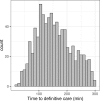Revision of 'golden hour' for hemodynamically unstable trauma patients: an analysis of nationwide hospital-based registry in Japan
- PMID: 32201736
- PMCID: PMC7066640
- DOI: 10.1136/tsaco-2019-000405
Revision of 'golden hour' for hemodynamically unstable trauma patients: an analysis of nationwide hospital-based registry in Japan
Abstract
Background: The 'golden hour' is a well-known concept, suggesting that shortening time from injury to definitive care is critically important for better outcome of trauma patients. However, there was no established evidence to support it. We aimed to validate the association between time to definitive care and mortality in hemodynamically unstable patients for the current trauma care settings.
Methods: The data were collected from the Japan Trauma Data Bank between 2006 and 2015. The inclusion criteria were patients with systolic blood pressure (SBP) <90 mm Hg and heart rate (HR) >110 beats/min or SBP <70 mm Hg who underwent definitive care within 4 hours from the onset of injury and survived for more than 4 hours. The outcome measure was in-hospital mortality. We evaluated the relationship between time to definitive care and mortality using the generalized additive model (GAM). Subgroup analysis was also conducted using GAM after dividing the patients into the severe (SBP <70 mm Hg) and moderate (SBP ≥70 mm Hg and <90 mm Hg, and HR >110 beats/min) shock group.
Results: 1169 patients were enrolled in this study. Of these, 386 (33.0%) died. Median time from injury to definitive care was 137 min. Only 61 patients (5.2%) received definitive care within 60 min. The GAM models demonstrated that mortality remained stable for the early phase, followed by a decrease over time. The severe shock group presented with a paradoxical decline of mortality with time, whereas the moderate shock group had a time-dependent increase in mortality.
Discussion: We did not observe the association of shorter time to definitive care with a decrease in mortality. However, this was likely an offset result of severe and moderate shock groups. The result indicated that early definitive care could have a positive impact on survival outcome of patients with moderate shock.
Level of evidence: Level Ⅳ, prognostic study.
© Author(s) (or their employer(s)) 2020. Re-use permitted under CC BY-NC. No commercial re-use. See rights and permissions. Published by BMJ.
Conflict of interest statement
Competing interests: None declared.
Figures




Similar articles
-
Substituting systolic blood pressure with shock index in the National Trauma Triage Protocol.J Trauma Acute Care Surg. 2016 Dec;81(6):1136-1141. doi: 10.1097/TA.0000000000001205. J Trauma Acute Care Surg. 2016. PMID: 27893619
-
The "mortality ascent": Hourly risk of death for hemodynamically unstable trauma patients at Level II versus Level I trauma centers.J Trauma Acute Care Surg. 2018 Jan;84(1):139-145. doi: 10.1097/TA.0000000000001706. J Trauma Acute Care Surg. 2018. PMID: 28930947
-
Traditional systolic blood pressure targets underestimate hypotension-induced secondary brain injury.J Trauma Acute Care Surg. 2012 May;72(5):1135-9. doi: 10.1097/TA.0b013e31824af90b. J Trauma Acute Care Surg. 2012. PMID: 22673237
-
Revisiting the "Golden Hour": An Evaluation of Out-of-Hospital Time in Shock and Traumatic Brain Injury.Ann Emerg Med. 2015 Jul;66(1):30-41, 41.e1-3. doi: 10.1016/j.annemergmed.2014.12.004. Epub 2015 Jan 14. Ann Emerg Med. 2015. PMID: 25596960 Free PMC article. Clinical Trial.
-
Low baseline (pre-injury) blood pressure predicts inpatient mortality in elderly trauma patients: A bi-institutional study.J Trauma Acute Care Surg. 2016 Dec;81(6):1142-1149. doi: 10.1097/TA.0000000000001144. J Trauma Acute Care Surg. 2016. PMID: 27244581
Cited by
-
The effect of a clock's presence on trauma resuscitation times in a Dutch level-1 trauma center: a pre-post cohort analysis.Eur J Trauma Emerg Surg. 2024 Apr;50(2):489-496. doi: 10.1007/s00068-023-02371-0. Epub 2023 Oct 4. Eur J Trauma Emerg Surg. 2024. PMID: 37794254 Free PMC article.
-
Do deaths from road traffic injuries follow a classical trimodal pattern in North West Ethiopia? A hospital-based prospective cohort study.BMJ Open. 2021 Dec 20;11(12):e051017. doi: 10.1136/bmjopen-2021-051017. BMJ Open. 2021. PMID: 34930730 Free PMC article.
-
Weather and prehospital predictors of trauma patient mortality in a rural American state.Surg Pract Sci. 2022 Mar 11;9:100066. doi: 10.1016/j.sipas.2022.100066. eCollection 2022 Jun. Surg Pract Sci. 2022. PMID: 39845067 Free PMC article.
-
Association of Scene Time with Mortality in Major Traumatic Injuries Arrived by Emergency Medical Service.J Emerg Trauma Shock. 2023 Oct-Dec;16(4):156-160. doi: 10.4103/jets.jets_35_23. Epub 2023 Oct 24. J Emerg Trauma Shock. 2023. PMID: 38292276 Free PMC article.
-
Current patterns of trauma center proliferation have not led to proportionate improvements in access to care or mortality after injury: An ecologic study.J Trauma Acute Care Surg. 2023 Jun 1;94(6):755-764. doi: 10.1097/TA.0000000000003940. Epub 2023 Mar 7. J Trauma Acute Care Surg. 2023. PMID: 36880704 Free PMC article.
References
-
- Cowley RA. A total emergency medical system for the state of Maryland. Md State Med J 1975;24:37–45. - PubMed
-
- Newgard CD, Meier EN, Bulger EM, Buick J, Sheehan K, Lin S, Minei JP, Barnes-Mackey RA, Brasel K, et al. . ROC Investigators . Revisiting the "Golden Hour": An Evaluation of Out-of-Hospital Time in Shock and Traumatic Brain Injury. Ann Emerg Med 2015;66:30–41. 10.1016/j.annemergmed.2014.12.004 - DOI - PMC - PubMed
LinkOut - more resources
Full Text Sources
Other Literature Sources
Research Materials
